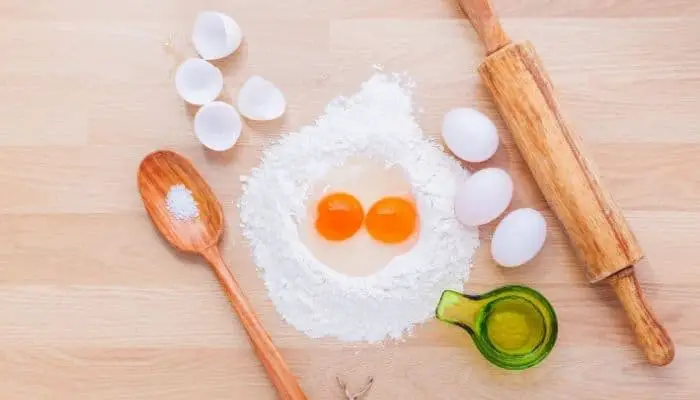You lovingly made pasta for everyone in the house and it was very chewy. How bad does it feel? I can understand your feeling very well. Initially, I use to search for the best pasta recipe and cook as instructed. But each time it turned rubber-like and I use to wonder- why is my pasta chewy? But the best thing is I never quit and I started trying different methods you can call it experiments too. Haha kidding!
The Internet is flooded with the answers like you didn’t knead well that’s why pasta is chewy. Or some say you over-knead the dough and it turns hard when cooked. Today I want to tell you how I make my pasta soft and tasty every time. The number of eggs and the quantity of flour, kneading, and even rolling plays an important role in pasta making.
More Interesting posts- Different things to do with cake mix? and what can I use instead of chocolate chips?
Why is My Homemade Pasta Chewy?
Your pasta is chewy maybe because it is undercooked or under kneaded or because didn’t give your dough proper time to rest. There are many mistakes that can make your pasta feel chewy especially if you are making fresh pasta at home.
It is always the best to search for the reason to find the perfect solution. Check out the following points if you are preparing for a fresh pasta bunch today.

You didn’t use the right flour
Using the right type of flour is of course important. But the truth is You can make pasta with almost all flours. However, you should always avoid using cake or pastry flour. When you are making pasta bet for flour with high protein.
Wheat type 00
Type 00 wheat is everyone’s first choice when it comes to pasta making. Flour type 00 is easily available and gives you the perfect textured pasta. For this flour, wheat is milled with a fine grind. You can use type 00 flour for a smoother texture. I mainly use this flour for pasta or pizza making.
Semolina durum wheat flour
This flour is a bit coarse than others. if you like textured pasta you should go for semolina flour. Usually, for pasta making, semolina durum flour is used with flour type 00 or AP. It is mixed to get perfect medium-textured pasta. Semolina flour is the best choice to make any shaped or textured pasta.
All-purpose flour
This is fine white flour which is commonly available. It is coarser than type 00 flour. All-purpose flour is not the best but you can use it. Just keep in mind for a perfect pasta dough you have to knead it more. This flour needs more kneading to achieve the perfect gluten bond for perfect pasta dough.
You can also use Ap flour. I have tried it many times and each time it turns amazing.
Egg and flour ratio
Some people use to add more flourless eggs and also add water to the dough. But you do not have to that. Just keep the measurement for 1 large egg for 100 gms of flour or 3/4 cups of flour.
Adding too much flour will make your dough very stiff and will make your pasta chewy too. So you just have to take eggs is the proper ratio. I use 2-3 whole eggs. For rest, I only use yolks like 5-6 yolks. You can do that too add more yolks and fewer eggwhites to the flour. Yolks will make your past soft and smooth textured.
Eggless kinds of pasta are usually a bit chewy. If you are not adding eggs, add olive oil. You can also use vegetable oils but I prefer using olive to get that perfect bond.

Kneading problem
Most of the people say over kneading leads to chewy or rubbery pasta. But my question is, why will you over-knead? Didn’t it hurt your hands? For me, there is no one in the earth who loves hearing his or her hands by over kneading the dough.
You just have to knead it until you get that ball. Whit a ball I mean your dough will become soft even textures that you can mold into a ball easily. To check it, you can poke your fingers, it should be back in the shame after a few minutes.
One more mistake that people repeat, again and again, is adding too much extra flour. Keep in mind, you already have talked flour and eggs in a perfect ratio and you do not need excess flour.
At first, make a pool using flour with a pin in the center and put all eggs into it. Use fork or spoon to beat yolks and eggwhites. Then slowly move towards flour and try mixing them together. After you mixed eggs and flour together add a pinch of salt to it. Not it’s time to use your hands.
I recommend using very little flour, Apply flour to your palms instead of adding to the mixture. It will help to prevent the dough to get stuck on your hand or fingers. You can sprinkle some flour while kneading and that’s also when needed.
Rolling problem
This is the biggest problem with pasta making. We generally use a roller to roll our pasta dough. It takes lots of effort and pressure to roll perfectly thin pasta. You need to roll it very thin as it gets thicker when cooked. If you roll thick pasta it will become even thicker. Hence, you’ll have to cook for more time.
The basic mistake we dis we role pasta very thicker than it uses to be. Then we cook it as we do with general thin pasta. Usually, we take out pasta from the water before it is completely cooked. This is also a big reason of chewy pasta.
When we make big batches of pasta, we usually do not cake about the rolling. We roll some batches very thing while some stay thicker. This carelessness can make your pasta stiff and also can ruin your mood. I prefer using a pasta roller for pasta of the same thickness or you can ask your family members for help.

Didn’t rest the dough
Resting the dough after each step is very important. If you are making fresh homemade pasta, you will need at least 1-2 hours. Do not do things in a hurry as it can result in stiff pasta. You have to properly knead the dough. Be ready for 15-20 minutes of hand exercise.
Knead the dough perfectly and wrap it in a cello wrap tightly. Then let it rest for 25-30 minutes at least. Many people let the dough rest for 2-3 hours but it is not needed. You can rest is and do you other preparation to utilize the time.
There must be a proper time gap between kneading and rolling. After resting the dough you will notice the change in texture too. It will become more soft and easy to roll. If you use an instant kneaded dough, you need to put more pressure to roll it. Some people say instant kneaded dough gets stick to the rolling pin for that you will need to use more flour and it is gonna make your pasta chewy.
Too stiff dough
If your dough is very stiff and can not be easily kneaded or rolled, your pasta can be stiff too. The perfect soft dough makes perfect soft pasta too. For a perfect dough choose the right flour and use the perfect egg flour ratio. If you are not using eggs use olive oil and use the right amount of water to make a soft dough.
Not cooked properly
Cooking is definitely the most important section. You have to cook it for max 5-7 minutes only. But this also depends on the thickness of the pasta. Thinnest pasta takes lesser time to get cooked. If you are adding thin pasta to hot boiling water it may take only 2-3 minutes to get cookies. Keep checking and stirring slowly.

Why is my pasta chewy?
It is maybe because your cooking technique is not correct. Keep in mind Boiling pasta is the crucial pasta of the whole procedure. If you cook it properly it will turn out amazingly. For getting a perfect boil to your pasta, you need to check several things including the temperature of the water.
First of all, make sure you are not adding pasta to cold water. It will result in our pasta getting stuck to the base of the pan. And cold water will make it gummy or sticky. To prevent this problem you need to boil the b=water to the highest.
Wait for the water to get to the rapid boil before adding pasta to it. After putting all the past into the pan wait again. And give the water a nice boil before switching off the stove. Keep checking the texture of the pasta, do not undercook or overcook it.
You can drain out the pasta from the boiling water just before it properly cooked. This technique actually works wonder as pasta continues to cook while it drains or you wash it off after boiling. But many people do this in a hurry and if it is too raw it will stick to the teeth and will not be pleasant.
I have seen many people boiling pasta and then fry it in oil along with veggies. If you are using oil to fry pasta keep in mind to not overdo it. Oil can give you a nice crunchy outer layer but from inside your pasta will become chewy.
I hope you got the point and now you will be able to cook firmer nicer pasta for you and your family. Keep trying and do not forget to use the techniques I have mentioned and most important do not forget to share your experience with me.
Note*
If you are cooking readymade pasta, cook it as given instruction.
